Growth-HackYour Facebook Page: How We Got 10K Real Likes in 6 Months
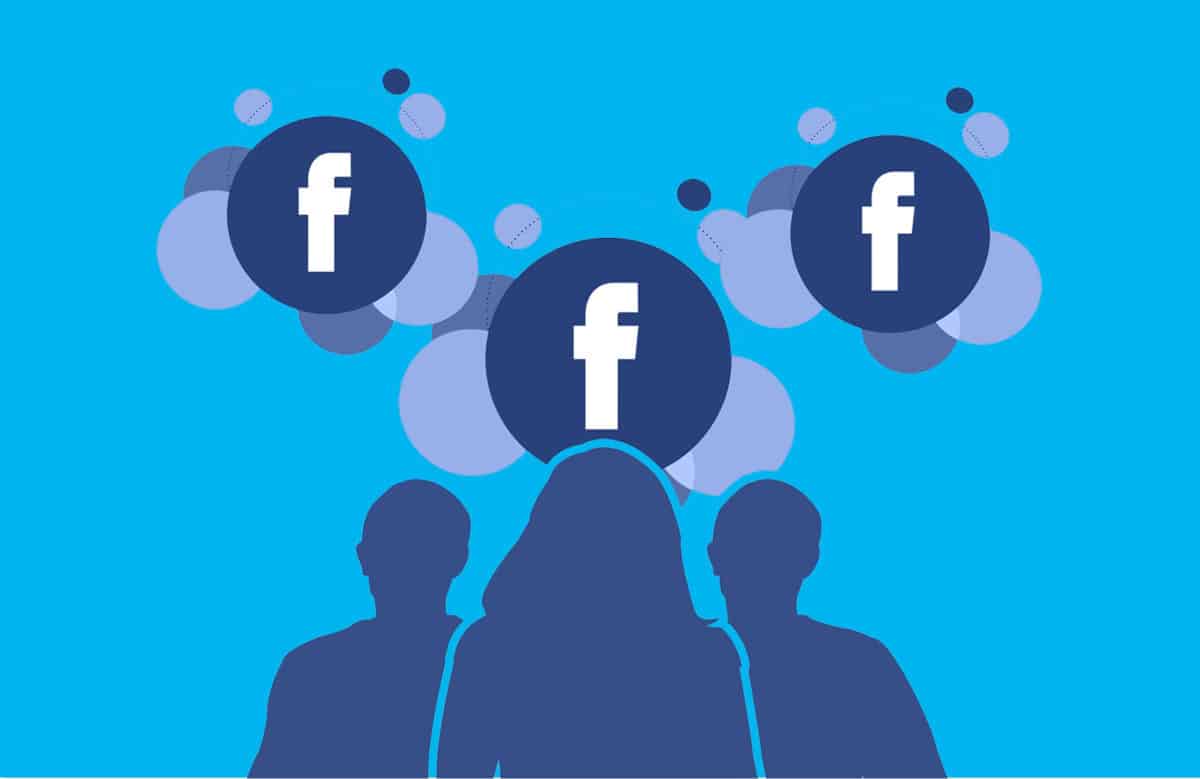
Want a heads up when a new story drops? Subscribe here
Ready to learn how to growth-hack your Facebook page?
Thanks to social platforms like Facebook, the barrier to entry into entrepreneurship has never been so low, the access to data has never been so easy, and the tools available have never been so powerful as they are today.
But you’ve got to have some skills to make these platforms work for you.
Editor’s note: This article was originally written by Eva Reder but has since been updated by Mark Simeoni, our expert social media manager who actively grew Foundr’s Instagram account to over 2.5 million followers.
One of the most popular and powerful of these tools is Facebook’s ads platform, which makes it possible to target people as specific as your gummy-bear-loving neighbor who’s getting married next year and does a lot of online shopping.
Consumer research and ads that previously might have cost you $100,000 can now be done with a few tests and Facebook ads. Those in the know are scaling multimillion-dollar businesses with almost no marketing costs. So, are you in the know?
If you’re not sure, worry not. In this case study, I will share some of my own secret sauce: How I growth-hacked my startup’s community to over 10,000 highly engaged, relevant, and very real fans, by spending just 6 cents per like and less than $1,000 in Facebook ads.
Ever since I figured out how to do this, I’ve replicated it for multiple other startups (you will see examples of this too!) and taught them how to growth-hack their Facebook pages, fine-tuning my formula every time. Here’s everything I’ve learned, the exact ad settings I’m using, and the underlying principles that will help you conquer Facebook posts and ads.
Get 70+ Proven Shortcuts for Growth Hacking any Business! Click To Join Our FREE VIP Waitlist Now.
The Anatomy of a Highly Engaging Facebook Post
The currency of Facebook marketing is the post, so right off the bat, let’s outline what makes up an engaging post. If you don’t know these basics, you may have trouble succeeding with Facebook advertising. The following tips can apply to both organic and advertised posts.
In the early days, we were way too focused on social media as an acquisition channel. We were impatient and saw it as a place where we keep users up to date about our development, ask them to test our app, and answer our surveys. We tried, failed, and learned our first lesson:
READ MORE: FREE TRAINING: Explode Your Instagram Account With Our IG Hacks Masterclass
1. Your page is about your audience, not your business.
The moment we stopped posting about ourselves and just focused on our audience and the kind of content they like, our page blew up. Don’t ask your followers to do something on every post—that’s not how you build trust. Nobody will engage. Don’t get impatient. In the beginning, before you average 30-40 qualified likes on every post, just produce content that is funny, entertaining, creates emotions, and brings real value to the community.
Value can come in many forms.
For us, the STEPPS model by Jonah Berger was a game-changer. In his book Contagious, he defines six buckets that sharable content falls into:
- Social currency (content that gives your audience status and leverage over others);
- Triggers (hooks that keep an idea top-of-mind and tip-of-tongue);
- Emotion (content that creates any kind of emotional response in people);
- Public topics (content about topics that the world is already talking about);
- Practical value (knowledge that people are looking for and can apply immediately such as cooking tutorials);
- Stories (stories that people can relate to).
Anything else will barely trigger engagement from an audience.
As for what does not fall into any of these buckets: asking for feedback, asking people to buy a product that they have never heard about, and keeping people “up-to-date” on what you are up to as a brand, without them having a relationship with you first.
Only once you have people’s trust and attention, can you right hook them and ask them to download your app. Don’t be romantic about whatever you think should be your message. You work for your audience. They dictate the type of content you post.
Here’s an example of a post that did not do well for “NomadApp” for the above-mentioned reasons and one that performed better after some adjustments.
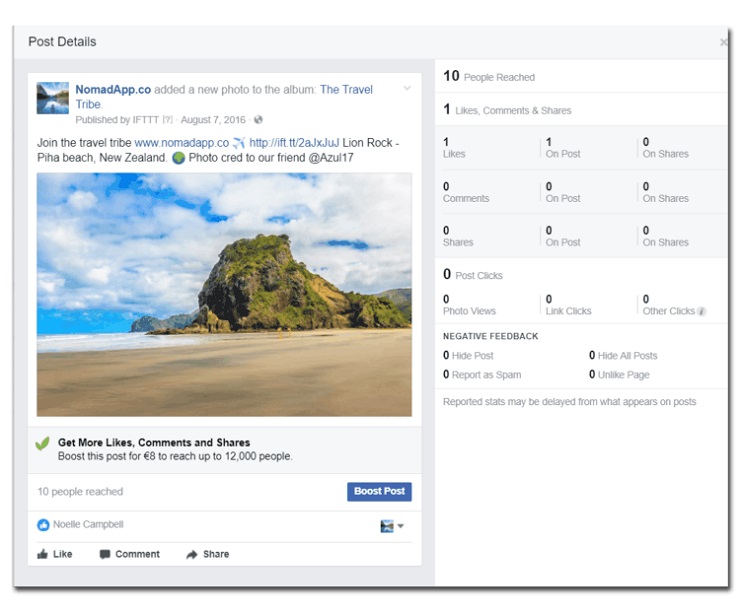 The post starts with an ask (“Join the travel tribe”) without explaining the benefit for the audience. It is also completely unrelated to the picture. You should never mix up two different calls to action in one post. The second big mistake is the “IFTTT” short link. IFTTT (If This Then That) is a great service to automate some of your business processes. However, the link on the timeline makes it easy for everybody to see that we published the post through an automation service which makes them lose trust.
The post starts with an ask (“Join the travel tribe”) without explaining the benefit for the audience. It is also completely unrelated to the picture. You should never mix up two different calls to action in one post. The second big mistake is the “IFTTT” short link. IFTTT (If This Then That) is a great service to automate some of your business processes. However, the link on the timeline makes it easy for everybody to see that we published the post through an automation service which makes them lose trust.
What is more, the second part of the post doesn’t match the beginning at all. We give a person a shout out but can’t tag them because it is their Instagram name. Big mistake. You should always share content natively (so if you share a picture on Facebook don’t tag them with their Instagram name; put in the extra work to find out what they are called on Facebook and tag them properly).
This post was seen by only 10 people for a reason. It didn’t deserve any more.
We learned from our mistakes. This is what one of our successful posts looks like.
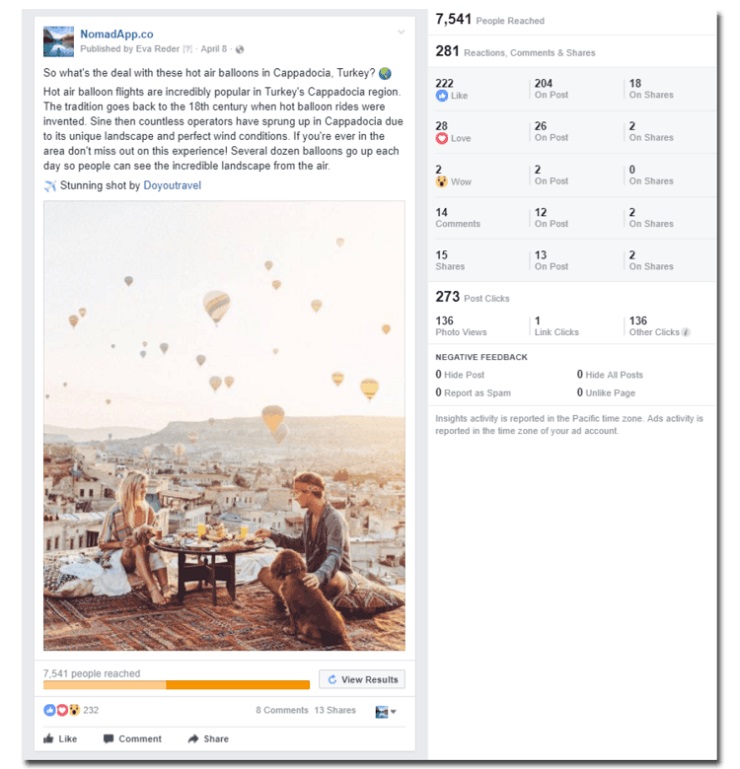
This post about Cappadocia is similar to the previous one in its concept, with one difference: we actually put in the work to bring value to the audience. The copy has one sole purpose—to inspire and entertain people. Why would people share this? Maybe to show their interest in travel? Maybe to show off on their timeline that they’ve been to this place? Sharing this place makes people look good on their timelines. Also, the post is well researched and we put in the extra work to find the Instagrammer’s Facebook page so we can tag them the right way.
The post got to over 60 likes organically within three hours. After seeing that it did well, we boosted it for $4 to fans of our page and their friends.
READ MORE: 30 Expert Tips on How to Get 10k More Followers on Instagram
2. Don’t link out too much, create native content.
Yes, it’s tempting to just use Buffer or a comparable tool to cross-post all your blog content on your Facebook page or link to your YouTube videos. Unfortunately, Facebook’s algorithm does not like you linking out of the platform. They are very greedy with their traffic and want to keep people on their website. Try providing most of your value directly in the post and upload videos natively.
You can really see the difference in this example below. The founder of Calroo Family Organizer, an app that helps you organize your busy family tasks, has been posting great content for over a year. However, the page wasn’t growing at all and had a low engagement. The reason? Most of the content was blog posts that she was just linking out to or calls to action without having built the necessary trust with the audience.
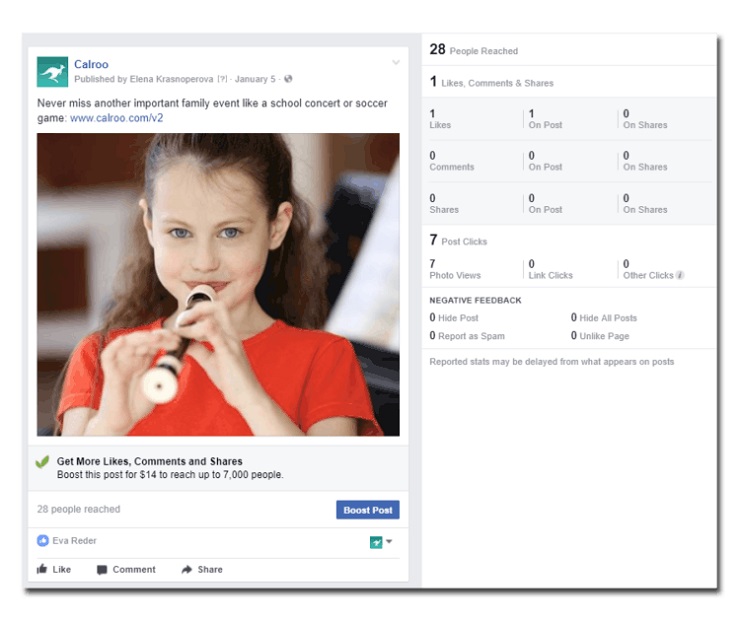 Whenever we started focusing on entertaining content within Facebook that the audience could relate to, engagement skyrocketed.
Whenever we started focusing on entertaining content within Facebook that the audience could relate to, engagement skyrocketed.
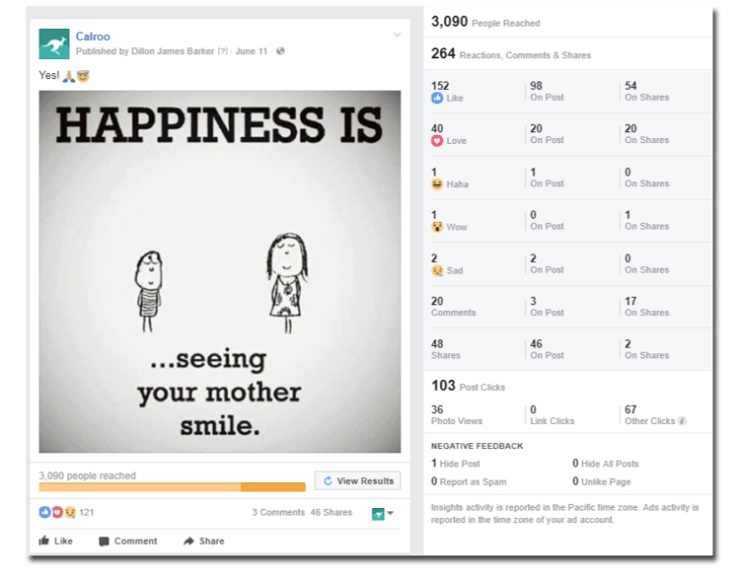
As a heads up, creating native content doesn’t have to be time-intensive. A great tool to create quotes or original designs is Canva. The tool makes it easy and fast to create content in batches and resize it so it is optimized for each social media platform (we don’t get paid to promote them, we just love what they do!)
3. Original content is not always the best content.
Don’t create until you’re a master at curation! Have you considered sharing viral content from other sources? Many times founders spend most of their time creating their own designs and pieces of content when they could have simply curated content that had already over-performed on other pages or social media platforms. Pay attention to copyright issues here, though.
Always credit the original content creator or ask for permission in case you are not sure whether you are allowed to share their content.
Curating popular content is a great way to get a feeling of what your audience likes without spending hours and hours creating it yourself. It’s like being a DJ for music your audience always likes. Once you have a better grasp of what performs well on your page, it makes sense to sprinkle in your own content, which will ultimately help you position yourself as a unique content creator and grow as a brand.
Now that you’ve got the basic principles on how to create relatable and shareable content at scale, we’ll jump right into the strategies on how to growth-hack your Facebook page.
We are focusing here on early-stage (consumer-facing) startups or individuals who want to build a personal brand and community. Once you know exactly who your target audience is, you can successfully execute the next three steps:
- Build a targeted, engaged community around your core topic and a shared interest by setting up a Facebook Likes ad campaign;
- Use boosted posts to feed into your community and to continue increasing Page Likes;
- Run successful ads that drive traffic and business to your website.
READ MORE: 10 Instagram Growth Hacks For More Engaged Followers (Without Running Ads)
Growth Hacking Facebook
1. Build a targeted community that likes your page and engages with your content.
Whenever you set up your Facebook page, you first want to build a community of people who will engage with your content.
Otherwise, it’s just not fun to produce high-quality content and get zero engagement. Just putting up great content may have worked in the past, but today it’s almost impossible to grow your audience purely organically (on Instagram, Twitter, or Pinterest it’s still easier).
So, as a first step, set up a hyper-targeted Facebook Page Likes campaign.
Our best-performing ad was the one called “Stolen from Competitors” (see screenshot below). If that worries you, we’re not really stealing from them, we just use their page fans in our target audience.
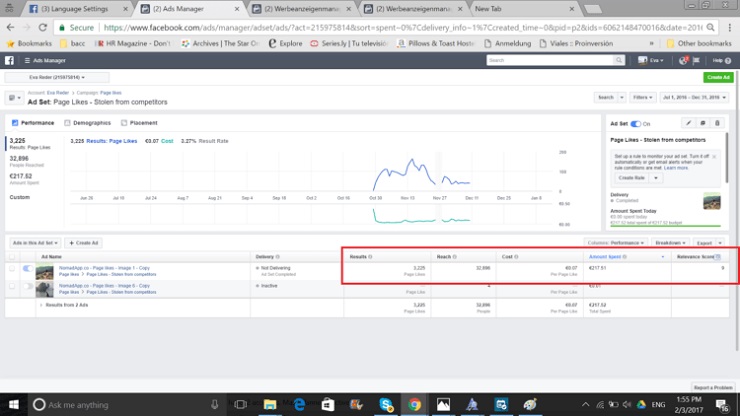
As you can see we got 3,225 page likes for only 7 cents each and a relevance score of 9 (out of 10). That is the best result of a campaign with targeted followers (not fake likes from click farms) I have ever seen.
How do you create an ad like that?
You do this by selecting “Engagement” as your objective and then “Page Likes”:
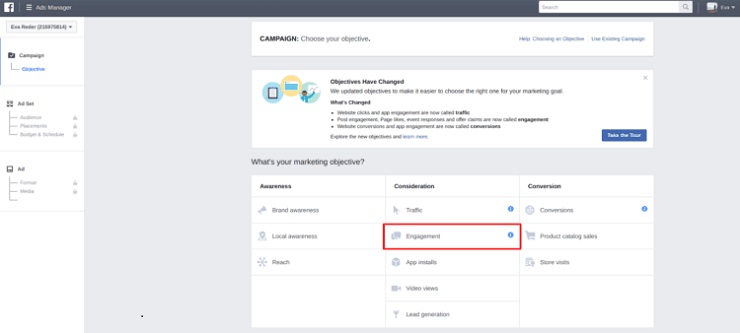
Go ahead and give your campaign a name, and you’ll see the campaign setup page where you pick your audience and design the ad.
The Key to a Successful Ad: The Right Target Audience
Facebook’s targeting tool is amazing. You can get as specific as “target moms that live in 64064 Lee’s Summit, Kansas City that are interested in Bakery Shops and buy a lot of stuff online with a credit card.”
Play around with the parameters and get to know the tool.
However, our best-performing ads target people who already like Facebook pages of other brands or influencers in our space. For NomadApp’s niche, it’s mostly other travel bloggers and influencers like Nomadic Matt, Traveldudes, World Nomads, etc. NOTE: not all pages will appear here; a page has to have a certain number of followers to qualify as an interest in the targeting tool.
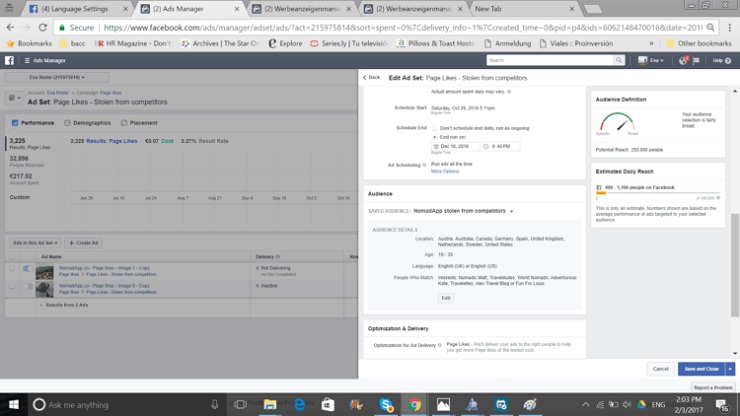
Here’s another example showing the targeting settings of an ad we ran for family organizer app Calroo, applying the same principles:
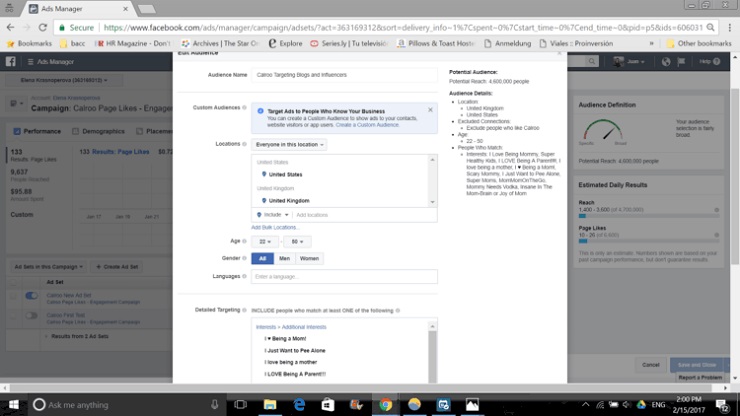
Again, we focused on targeting big Mommy Blogs, parenting pages on Facebook, and niche communities that have engaged audiences themselves.
READ MORE: 3 Ways to Create a Facebook Sales Funnel That Will Convert Customers on Autopilot
Why target other pages?
You’ll want to target audiences of pages or communities that already did the work for you. Why? Those leads are more likely to convert and are, thus, cheaper.
Don’t target people based on interests like “parenting” or similar categories. These are too broad. You don’t know whether these people are likely to engage. Better yet, target a page in your field that gets a lot of engagement. As a rule of thumb, I would suggest only targeting pages that average at least 30 likes per post.
But don’t go for huge publications or pages. Imagine targeting followers of Airbnb when you’re targeting backpackers. Airbnb has millions of likes on Facebook, but they are not specific enough. Your mom might like Airbnb, but she will most likely not engage with your backpacker, low-cost, travel-hacking startup.
It’s much better to target small blogs and influencer pages that have high engagement. Find the sweet spot with pages that are not so big that they have a ton of irrelevant followers, and not so small that they don’t qualify as an interest category on Facebook. That sweet spot usually lies between 25,000 to 200,000 followers.
We suggest the following process: Do a bit of research by just browsing through Facebook looking for big influencers in your niche. Check how good their engagement is on the page (you don’t want to target pages with thousands of followers but zero likes on their posts), add them to your list of target accounts.
Then go back to the Facebook Ads Audience Tool and look up the pages from your list to check whether they qualify as an interest. Once you’ve done this, click on suggestions and see other pages that Facebook thinks are similar.
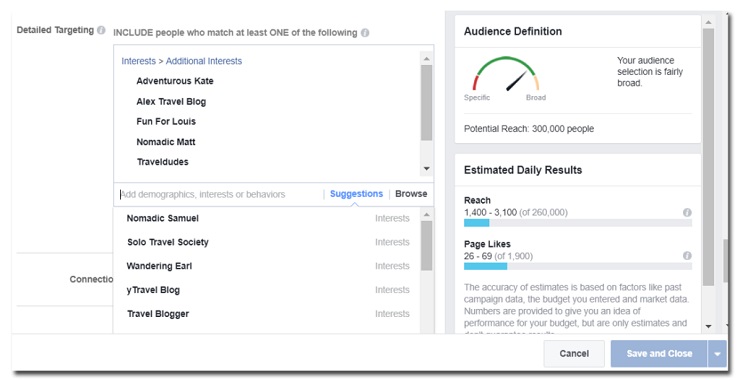
In the above screenshot, you can see what these suggestions look like in Facebook’s audience tool. If you don’t know them, research and make sure they fit your audience and get proper engagement. If they do, add them to the list of target accounts and repeat this process until you have a minimum of five different pages on your list. Make sure to click “Save This Audience”.
Ad Creative
Facebook lets you upload up to six different images to test which one does best. Test different images and after a day put the whole budget towards the one that did best in terms of cost per like or cost per click and click-through rate.
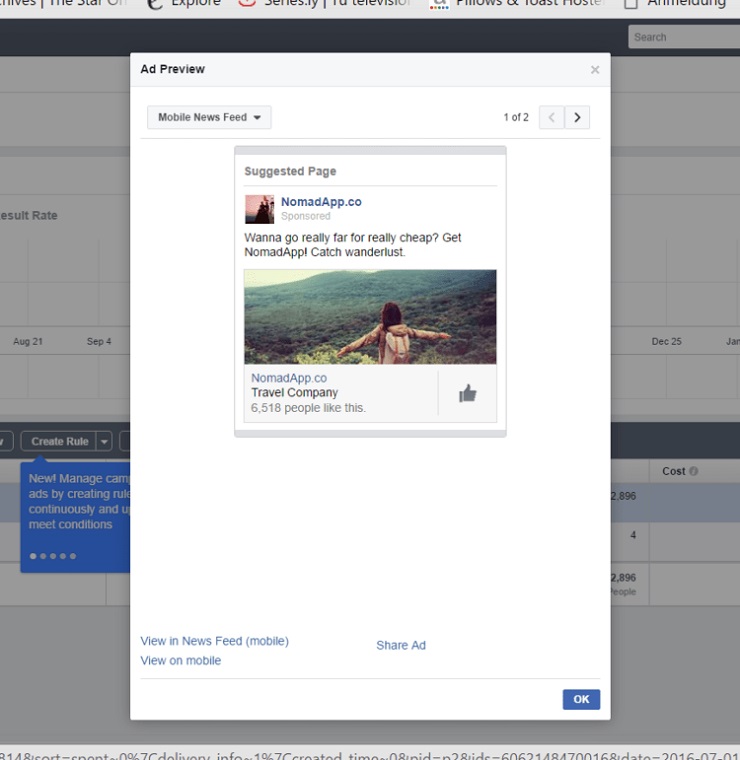
Here’s another ad we created for Calroo: The cost per like right now is at $0.27 with a relevance score of seven.
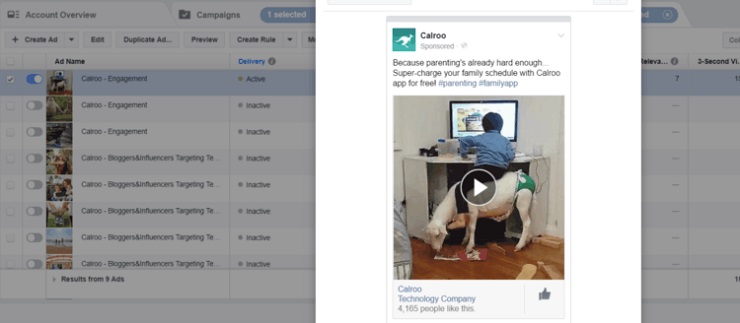
As for the text, we usually use this formula:
- Question or statement that sparks interest
- Value proposition and benefit to the audience
- Call to action
For example, NomadApp’s ad text is, “Wanna go really far for really cheap?” (Question that sparks interest and shows the benefit to the audience); “Get NomadApp! Catch wanderlust!” (Call to action).
This ad strategy got us up to more than 10,000 likes on our page NomadApp in fewer than six months for less than $1,000 total.
READ MORE: 7 Powerful Tactics to Get More Followers on Snapchat
2. Use Boosted Posts to Increase Engagement
After you get some likes to your page, it’s important to boost engagement on your posts to get more interaction so you can build your community and create more interest in your brand. You can also use this strategy to invite more people to like your page (more on that later).
Why boost posts to your own audience and their friends? Because they already know you and are more likely to engage with your content than a cold audience would.
For a long time, we were reluctant to spend any money on Facebook’s boosted posts. However, it is a fact that Facebook limits organic reach for business pages and only shows posts to a fraction of your audience. We have learned that a very small budget in boosted ads can go a long way and helps us engage with a bigger percentage of our fans.
On posts that already do well, click “boost post” and create an ad to reach more people.
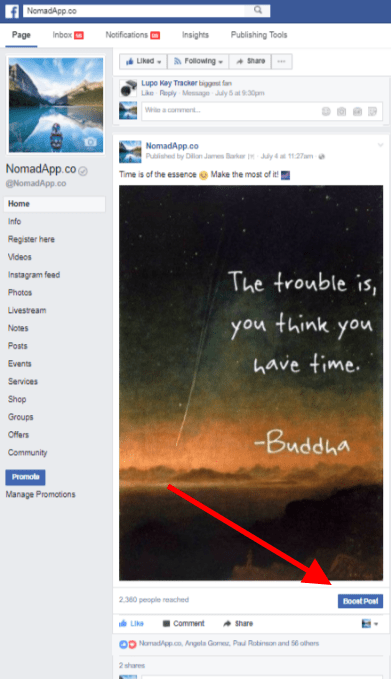
After you hit the Boost Post button, the audience settings will pop up.
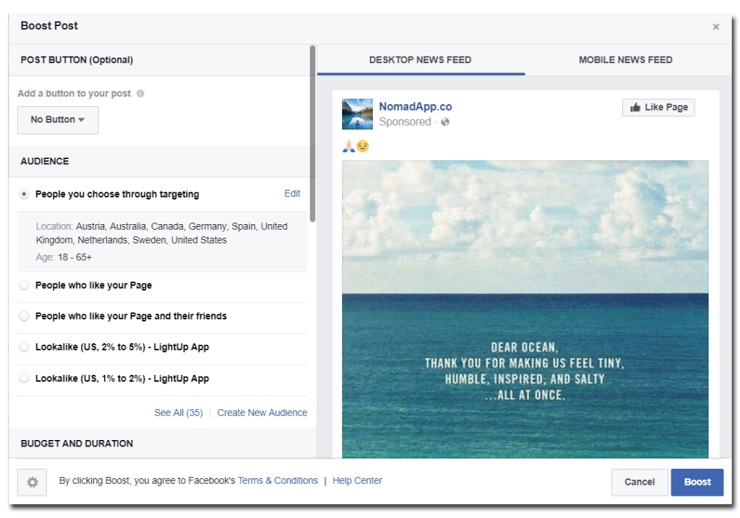
We successfully use a three-step approach that we learned from Scott Oldford for boosting posts:
- The first day: Boost the post to your own audience for as little as $1 or $2 = “warm audience.” They are the most likely to engage with your content and will add social proof to your post by liking and commenting.
- The second day: Boost the post to people who like your page and their friends $1 = “warm audience.” They will see their friends have already engaged with the content and are very likely to engage as well.
- The third day: Boost the post to people you choose through targeting $2 – $5 = “cold audience.” By now, your post has plenty of likes, comments, and shares. This audience will feel comfortable engaging with the post.
Once the ad is over, go to the list of people who liked the post and invite them to like the page if they don’t already.
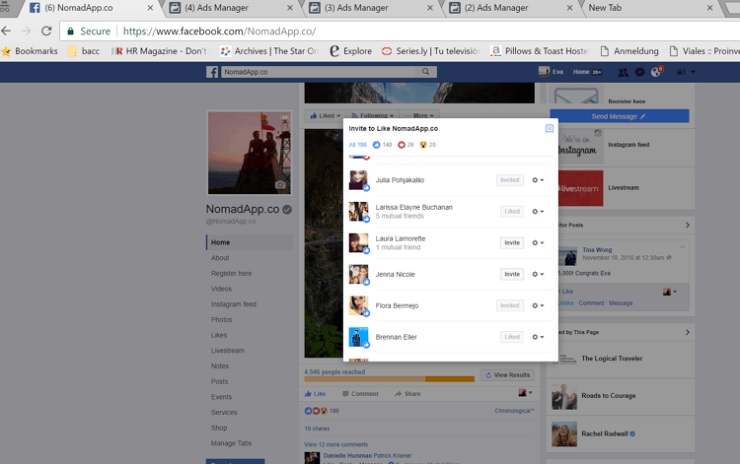
In our experience, not everybody will follow your invitation but a percentage of them definitely will.
3. Run Successful Ads to Drive Traffic and Business
Below is the Facebook ad we used to help our client sell a $400,000 house. These ads (also called dark posts) are those that send traffic directly to your website.
We call them dark posts because they don’t show up on your page, but rather appear as an ad in the newsfeeds of people you target. You can create ads easily from the ads manager platform on Facebook. We like choosing “traffic” as our objective, in order to send as many people as possible to the content on our website.
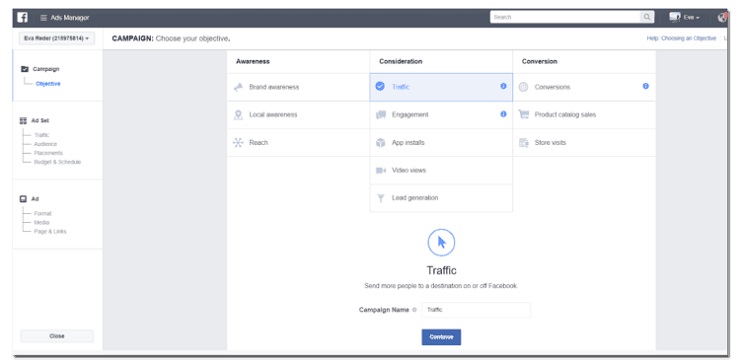
It was through these ads that we sold a $400,000 house for Greenovate Construction.
With a total budget of $300 in ad spend, we got 600 website visitors, 40 leads (at $1.10 each) and one sale. We also sold a $300,000 house with $400 in Facebook ad spend. Totally worth it!
To get these kinds of results, we used the same strategy as we did with the page like campaign for NomadApp previously. We targeted people who live in the area and follow construction topics, have an interest in green living, and work for companies that pay well enough to make sure they are qualified leads.
Here is a sneak peek at the settings of the ad:
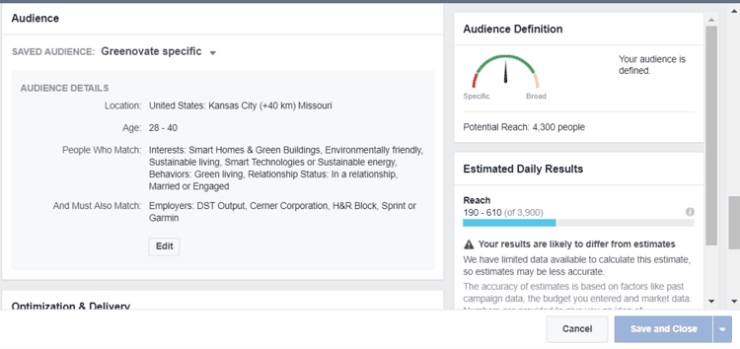
As for the actual ad creative and text, we followed our proven framework of spark interest, explain benefit, call to action.
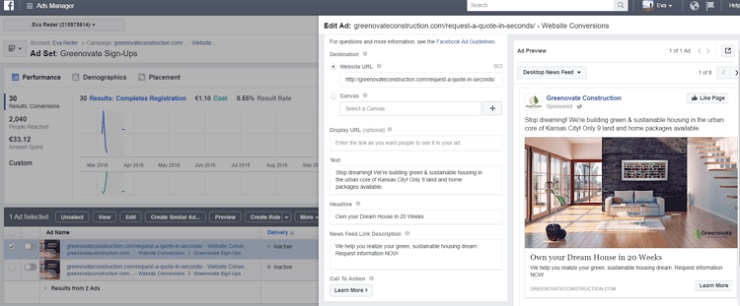
It worked like a charm!
As long as you understand the main benefit you are providing for your target audience, you will be able to generate similar results with this ad strategy.
Get 70+ Proven Shortcuts for Growth Hacking any Business! Click To Join Our FREE VIP Waitlist Now.
Ready To Growth Hack Facebook?
Facebook ads are extremely powerful and cheap if managed right. The possibilities are endless, and hopefully, this case study will help you skyrocket your own results. If you have specific questions feel free to reach out and we’ll try to help you with a specific plan!










0 Comments